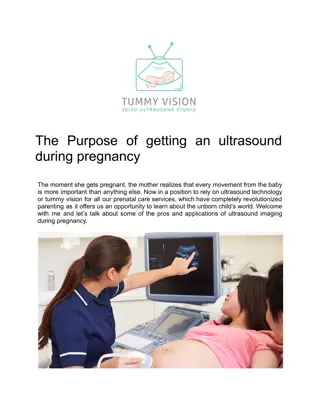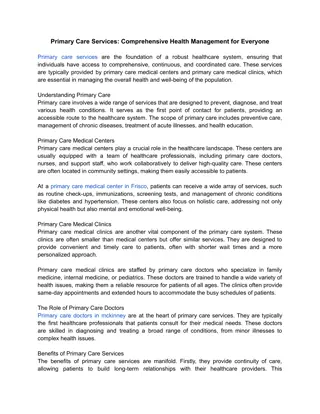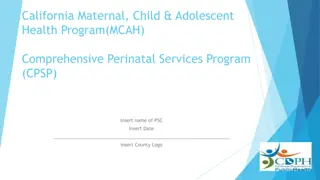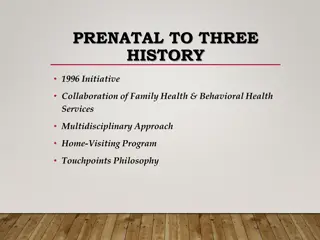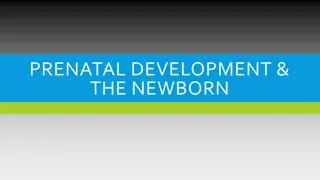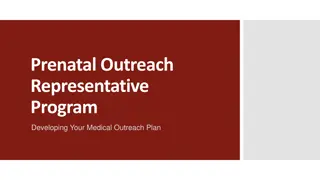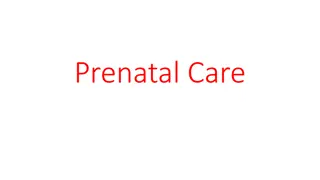Comprehensive Prenatal Assessment and Care Overview
Prenatal assessment involves systematic supervision and care for pregnant women to ensure good physical and mental health, decrease maternal and infant mortality, and prepare for labor and postnatal care. It includes physical assessments, history taking, and scheduling of visits to promote overall well-being throughout pregnancy. The process covers personal, medical, surgical, family, and menstrual histories, ensuring early detection and appropriate management of any conditions that may pose risks to the mother and baby.
Download Presentation

Please find below an Image/Link to download the presentation.
The content on the website is provided AS IS for your information and personal use only. It may not be sold, licensed, or shared on other websites without obtaining consent from the author.If you encounter any issues during the download, it is possible that the publisher has removed the file from their server.
You are allowed to download the files provided on this website for personal or commercial use, subject to the condition that they are used lawfully. All files are the property of their respective owners.
The content on the website is provided AS IS for your information and personal use only. It may not be sold, licensed, or shared on other websites without obtaining consent from the author.
E N D
Presentation Transcript
Physical assessment prenatal assessment : . . .
objectives 1-to promote and maintain good physical and mental health during pregnancy. 2-to ensure a mature, live, healthy infant 3-decrease maternal and infant mortality and morbidity 4-to prepare the woman for lebor, lactation, and subsequent care of the baby 5- to detect early appropriately condition (medical and obstetrical) that would endanger the life and impair the health of the mother and her baby
Prenatal assessment Systematic supervision of a women during pregnancy, and care give to the pregnant women during the period between conception and onset of labor, also can called (antenatal care)
Schedule of prenatal visits 1-initial prenatal visit : Establish baseline data relevant to planning health promotion strategies now and with every subsequent visit. The initial assessment interview can establish the trusting relationship between the nurse and the pregnant women. During the first visit, assessment and physical examination must be complete. 2-follow-up visit: Once / month through 1-6 month of pregnancy. Two/ month (every 2 week) 7-8 month of pregnancy. Four/month(every 1week)9month of pregnancy.
History A) Personal history Name - husbands name Age - Age Education -Education Occupation -Occupation Duration of marriage - address Consanguinity -economic status B)medical history Diseases DM, hypertension, heart disease, drug and allergies . Other (blood transfusion, Rh incompatibility. X ray exposure C)surgical history - previous operations Vaginal repair Cesarean section(C/S)
D)Family history DM Hypertension Renal and cardiac disease Cancer Anemia History of twin pregnancy E)menstrual history: Age of menarche Last menstrual period (LMP) Regularity and frequency of menstrual cycle Contraception method Any previous treatment of menstrual Expected date of delivery (EDD)
f)Obstetrical history This provides essential information about the previous pregnancies that may alert the care provide to possible problems in the present pregnancy. Gravida, Para, abortion, and living children. Weight of infant at birth & length of gestation. Labor experience, type of delivery, location of birth, and type of anesthesia. Maternal or infant complications.
General examination A) Physical examination B) Abdominal examination C)Pelvic examination A)Physical examination: Is performed by the physician or midwife during the first visit to assess the general state and to evaluate the pregnancy. It includes 1-overall appearance: happy or sad, clean or dirty, overweight or underweight.
2-Vital signs, height, weight measurement Blood pressure: - It is taken to ascertain normality and provide a base line reading for a comparison through the pregnancy Pulse: - The normal pulse rate 60.90 beat/minute . - At 14-20 weeks of gestation, the pulse increase about 10-15 beat/minute. - Tachycardia is associated with anxiety, hyperthyroidism, or infection. Respiration : - The normal is 16-14 BPM. - Tachypnea may indicate respiratory infection, or cardiac disease. Temperature: - Normal temperature during pregnancy is 36.2C to 37.6C. Increased temperature suggests infection.
Weight changes: During pregnancy continuing weight increase in pregnancy is considered to be a favorable indicator of maternal adaptation and fetal growth -4.0 Kg in first 20 weeks -8.5Kg in second weeks -12.5Kg approximate the total weight gain. Body mass index(BMI) Your body mass index is the balance between your height and weight it is recorded in your pregnancy notes BMI measurements: weight(Kg) BMI less than 18.5= under weight. BMI=___________ BMI 18.5= healthy weight. (Height (M))2 BMI over 25= over weight. BMI over 30= obese BMI over 40= seriously obese
Also raised BMI affect pregnancy: -DM -hypertension -UTI -pelvic joint pain -blood clots BMI can affect your labor by increased risk of -induction of labor -A longer labor -A cesarean section -Difficulties in hearing baby's heart beat -Larger baby's -heavy bleeding after delivery
B)Abdominal examination: 1-inspection: the nurse should look at the following: Abdominal symmetry Movement of respiration Skin changes such as linea nigra, striae gravidarum. Scars of previous operations Fetal movement visible. 2-palpation: Measurement of uterine size form the upper most point of the fundus to the pubic symphysis (cm). Assess fetal lie: longitudinal, transverse & oblique. Assess fetal presentation : breech , cephalic. 3-Auscultation: fetal heart beat can be heard by stethoscope after the 20 week, or Doppler after 8 week. *(normal fetal heart rate is 120-160 beats/min)
Palpate the height of fundus Fundus felt above pubic symphysis 12 weeks after LMP At 16 weeks, halfway between symphysis and the umblicus At 20 weeks, at umbilicus By 36week, the fundus is just below the xiphisternum
The uterus may be higher than expected 1-Large fetus, multiple pregnancy 2-Polyhydramnios 3-Mistaken date of last menstrual period The uterus may by lower than expected 1-Small fetus, intrauterine growth restriction 2-oligohydramnios 3-mistaken date of last menstrual period 4-fundul palpation is performed to determine whether in contains the breech or the head. This will help to diagnose the fetal lie and presentation Braxton hicks contraction:(after 16 week) Are irregular, painless, occur intermittently throughout pregnancy. These contractions aid in moving the cervix from the posterior position to the anterior position, they also help in ripening and soft of the cervix
Leopold's maneuvers A-First maneuvers: palpation of the fundus B-Second maneuver: palpation of the fetus's back C-Third maneuver: assessment of presenting part D-fourth maneuver: assessment of the presenting part's descent into the pelvis A B C D
C)Pelvic examination: The external genitalia are examined for lesion, scars, and infection. Cervix is checked for condition, color, and amount of secretion. Ultrasound: is performed to: Estimate the gestational age Check the amniotic fluid volume Check the position of the placenta Detect the multi fetal pregnancy The position of the baby Fetal kick count The pregnant woman reports at least 10 movements in 12 hours. Absence of fetal movements precedes intrauterine fetal death by 48 hours.
Laboratory tests Rubella titer to assess immunity to rubella Complete blood count to detect anemia or infection Blood group, Rh Infectious disease screening(venereal disease research laboratories VDRL) to detect untreated syphilis, HIV Urinalysis and urine culture to test for glucose, ketones, blood asymptomatic bacteria & protein
Nutritional requirements Carbohydrates: The carbohydrate and caloric needs of the pregnant woman increase during the last two trimester it is promote weight gain and growth of the fetus, placenta and other maternal tissue. It found in fruits, vegetables & breads . Proteins: Increase protein intake is needed for: -expansion of blood volume -tissue growth -provision of adequate amino acid for fetal development -daily requirement for pregnant women is 60g -found in the meat, fish, poultry egg.
Calcium and phosphorus : - Calcium and phosphorus involved in mineralization of fetal bones and teeth. - Daily requirements for pregnant woman is 1000mg. Iodine: - Is essential for thyroid hormone - Daily requirements for pregnant woman is 220mcg Zinc: - Synthesis of DNA and RNA it essential for normal fetal growth and development. - Daily requirements for pregnant woman is 11mg - Sources meats, poultry whole grain, and legmes.
magnesium -essential for mineralization of bone. -daily requirements for pregnant woman is 350mg/day -good sources include milk, whole grain, green vegetables & nuts. Folic acid: - Foliate an essential coenzyme for DNA & protein synthesis in developing fetus. - Daily requirements for pregnant woman is 400-600mg. - May help prevent major birth defects of the baby's brain and spine called neural tube defect. - Sources include green leafy, vegetables, dried beans.
Iron: - This extra iron helps your body make more blood to supply oxygen to your baby. - Not having enough iron is called iron deficiency anemia. - Anemia increase the risk of certain problems, including - Preterm delivery - Low-birth-weight baby - Which is found in most prenatal vitamin supplements - Daily requirement for pregnant woman is 40-60mg
vitamins Vitamin A -is associated with the formation and development of healthy eyes in the fetus. -the RDA is 770mcg per day. -sources include yellow vegetables organ cream butter milk. Vitamin B -important in skeletal development -pregnant woman 5 meg per day Exposure of ultra violate ray sunlight is important sources of vitamin D Vitamin E -decrease of the oxidenation of polyunsaturated fats. Also effect on the health of the body cells also important in formation of the red blood cells -the recommended intake is 15 mg per day -it is found in oils whole grain greens and eggs.
Immunization The woman should have(tetanus toxoid) injections during pregnancy. TT1: At 4 month of pregnancy TT2: At 5month pregnancy TT3: Booster dose after 6 month from 2 dose TT4:Booster dose after 1 year from 1 booster dose. TT5: Booster dose after 1 year from 2 booster dose or during next pregnancy.
Responsibilities of nurse in antenatal assessment 1- complete assessment of its history. 2- participating in physical and obstetrical examination. 3- Identification of patient needs. 4- providing initial education and counseling.
References 1-the ALPHA scale : the antenatal psychosocial health assessment scale (department of family, medicine, university of toronto,canada) 2-WebMD medical reference reviewed by kacia gaither, DM,MPH on october21,2018 3-Jump up to :whitwork, M ,bricker;C(14 July 2015). Ultrasound for fetal assessment in early pregnancy the Cocbrane Database of systematic review .7: CD007058.doi: 10. 1002/14651858. CD007058. pub3. PMID 26171896 4- Antenatal care for uncomplicated pregnancies; .NICE. National institute for health care and excellems. retrieved September 23, 2017





